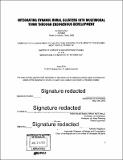Integrating dynamic rural clusters into multimodal town through endogenous development
Author(s)
Sun, Qiuying
DownloadFull printable version (48.63Mb)
Alternative title
Village investigation and design in Anhui Province
Other Contributors
Massachusetts Institute of Technology. Department of Architecture.
Advisor
Adèle Naudé Santos.
Terms of use
Metadata
Show full item recordAbstract
Cities in China have a longstanding reputation of monotonous and hegemonic speculative urbanization. In the recent decade, real estate development transformed a large amount of arable land into urban periphery. This lead to the gross amount of farmland in China to reach near security levels for national reservation. Since then, the existing mode of land finance in cities can hardly maintain the speed of rapid economic development. In 2006, the central government of China reoriented investment by shifting the priority in infrastructure investment to the countryside. Many villages are rich in natural and historical resources, as well as sources of a large amount of potential labor supply and consumption demand. Therefore, the complementary development between rural and urban construction will trigger the next wave of national economic growth in China. The binary structures of rural and urban development have sustained since the establishment of hukou system in 1958. This mode of segmentation channeled rural wealth to cities. Recently, the land quota bidding system between cities and villages triggered the combination of fragmented villages into towns. However, similar to urban development, many new towns were established with monotonous and tedious settings by utilitarian developers using similar design methodologies with the mode of urban development. The existing movement of townization segregated the original modes of rural life. The thesis aims to establish a language tailored for rural design in China by constructing a multimodal town through endogenous development. Different from city planning, village planning considers dynamic movement processes, small scale property rights, and complex environmental contexts. Different layouts of farmstead, field and infrastructure are always a compromise on either the efficiency of production or efficiency of infrastructure. The fundamental questions are how to integrate the population, how to obtain the investment for construction, and how to eliminate the binary structure of architecture and landscape in a rural environment.
Description
Thesis: S.M., Massachusetts Institute of Technology, Department of Architecture, 2016. Subtitle on page 3 reads: Village investigation and design in Anhui Province Pages 221-222 are blank. Cataloged from PDF version of thesis. Includes bibliographical references (pages 210-213).
Date issued
2016Department
Massachusetts Institute of Technology. Department of ArchitecturePublisher
Massachusetts Institute of Technology
Keywords
Architecture.